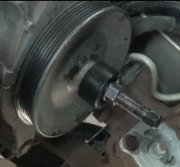That's way too many weights if they're all on the same wheel. It's very rare to not need at least one weight per side per wheel. Sometimes mechanics don't have the right size so they'll put on two smaller ones that add up to the needed total. Three weights suggests the wheel balancer is out of calibration or has a bad bearing on the shaft. By the time you find a lot of weights, something else is wrong and was overlooked. You won't find a car coming from the manufacturer that way.
Ten weights means there is a huge balance problem. A bent wheel will show up as needing a lot of weight but while adding that much weight may satisfy the balancer, you're going to feel that when the tread is on the ground. The additional clue to a bent wheel is you'll find almost the same amount of weight on the inside of the wheel, halfway around it from the weights on the outside.
Also add up the weights listed on each one. It's not uncommon to need three or four ounces on an older wheel and tire, but new ones typically balance out with much less. You can expect a new car to come with one ounce or less per wheel per side. A one-ounce weight is just over an inch long.
Tuesday, January 8th, 2013 AT 1:04 AM


